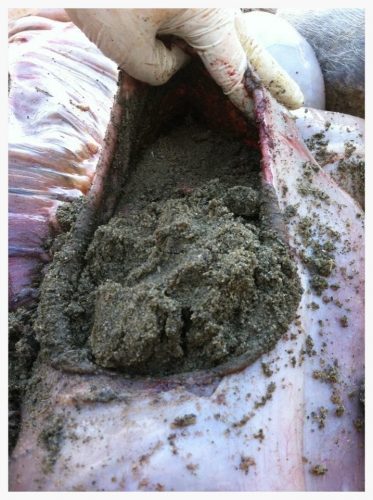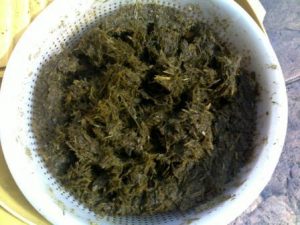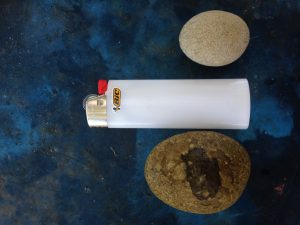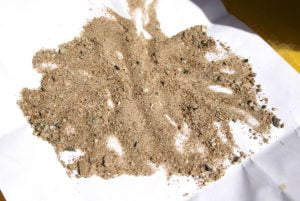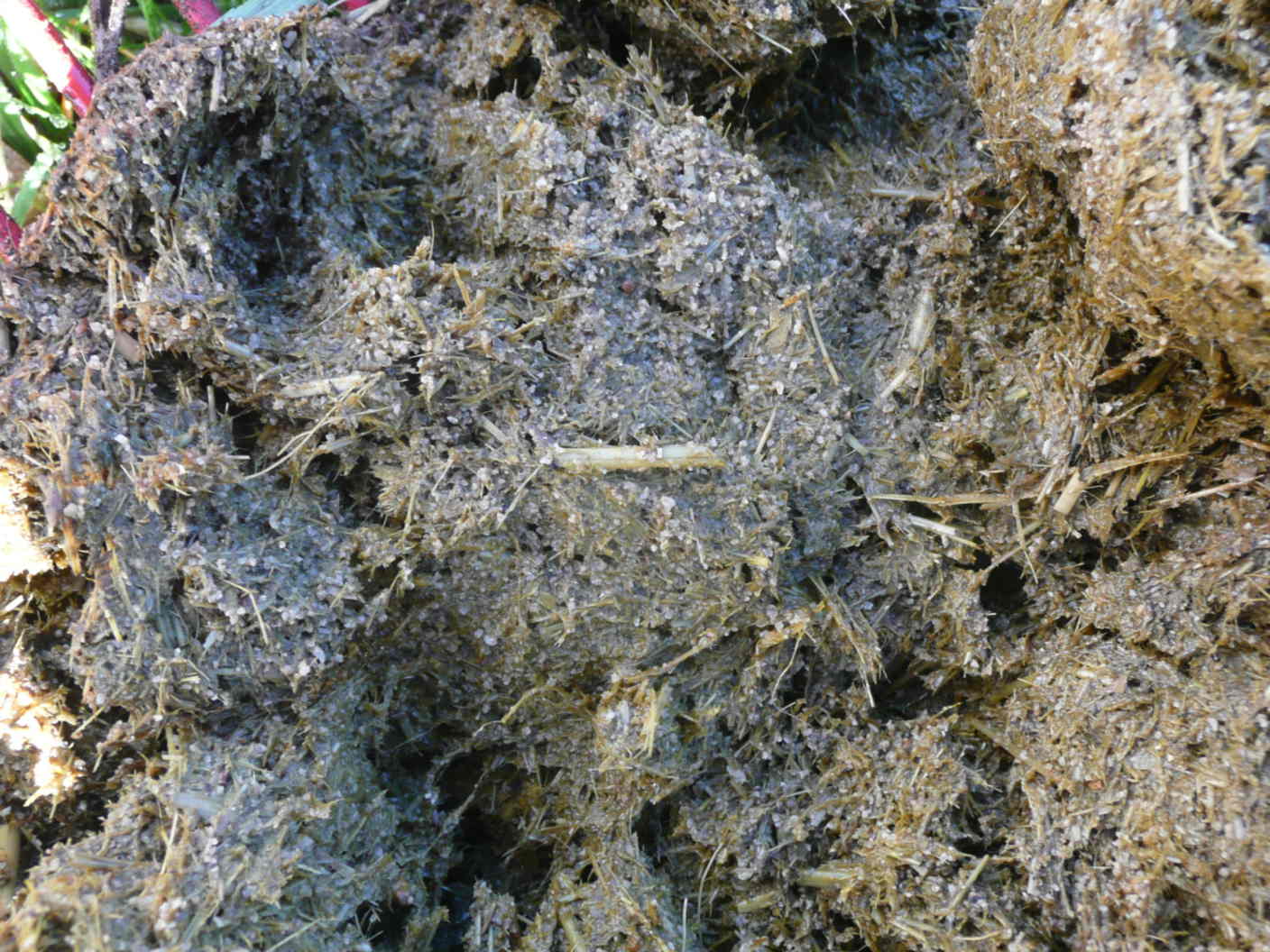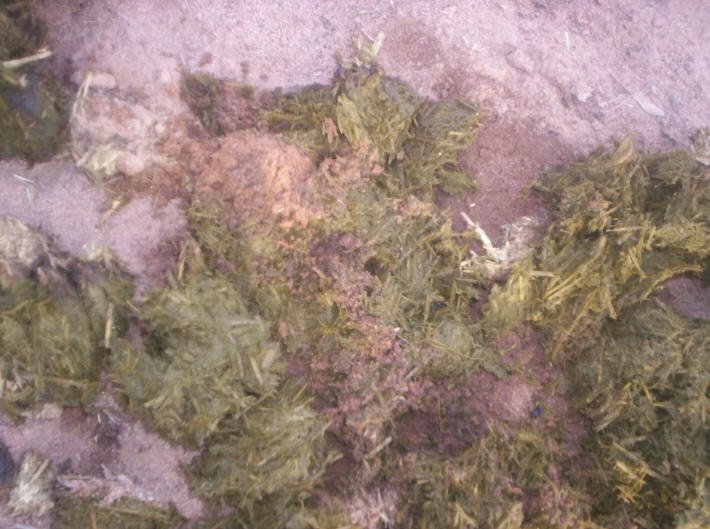PLEASE NOTE
This all Natural, it comes to You as Interlectural Property that will guard Your Horses throughout Life and possible save You Thousands. We have NEVER had a case of Sand Colic!
Read the many Stories below or go here to buy for a token $25, to cover my Insurance and much time spent on the Phone with Friends.
O’Leary Sand Colic Prevention Remedy
It is NOT AS SIMPLE as they dangerously write on Internet Forums!!!!!! – Don’t put Your Horse at Risk!!
FOR THE RECORD
This was invented by my Uncle, Jo O’Leary, a highly regarded Country Vet, 60 Years ago. in Naracoorte. South Australia. He had Racing Stables, housed on Sand Hills in the Town.
It was placed on the Internet, by me, in the Year 2001 and has helped Thousands of lovely Horses and saved hundreds of lives.
O’Leary Sand Colic Prevention Remedy
LATEST CASE.
2017 – OUTBACK SOUTH AUSTRALIA
Victor Harbor Vet advises our Product when other attempts failed on a Horse from at Roxby Downs. Success! – Well done brave Vet 🙂
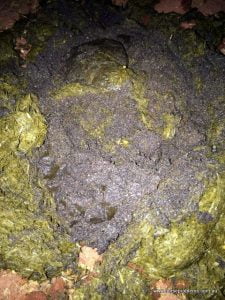
Horse Life saved Roxby Downs
14/3/16
I make the following points:
-
- Here and in other Countries, Vets’ prescribe paraffin oil as a treatment, cure, prevention. I do not believe that this treatment removes THE MAJORITY of sand. Further, I cannot find any documented studies that proves it works and worst still, we have proven time and time again that it does not work. A big statement coming from a lay person but we have saved the lives of horses, 7 days after being treated by well respected Vet’s. Many times. They had treated with paraffin oil and common additives. (See cases)
13/8/21 – I note that some Vets’ are advising precicely what I just wrote above.
- Here and in other Countries, Vets’ prescribe paraffin oil as a treatment, cure, prevention. I do not believe that this treatment removes THE MAJORITY of sand. Further, I cannot find any documented studies that proves it works and worst still, we have proven time and time again that it does not work. A big statement coming from a lay person but we have saved the lives of horses, 7 days after being treated by well respected Vet’s. Many times. They had treated with paraffin oil and common additives. (See cases)
-
- Psillium is held aloft as the wonder treatment for the prevention of Sand Colic. I cannot find any definitive documented proof that this works? Why is it that businesses all over the world sell it and label it as a prevention to Sand Colic when they have no proof? I have contacted many of them. Likewise, ‘Sand Lube’ named products….no documented proof. I don’t doubt that it could work however.
-
- There is a Fodder sold in the Eastern States (name escapes me) that is supposed to rid sand from the gut of horses. I contacted them. No available proof.
-
- I see people forced from the Equestrian Industry because of the massive cost of Veterinary treatment for Sand Colic.
-
- Where is the educational brochures for horse owners? The lists of how to prevent Sand Colic? (other than the propaganda regarding psyllium)
-
- A Grant was issued by the Western Australian Government, to a private Company for research into developing a pellet that would aid in the prevention of sand colic. I have not been able to get proof of the success or failure of that process.
January, 2015 (South Africa)
Dear John I had to share this with you. After recurrent colic and $3K in vet bills and no clear answer as to why someone put me onto your recipe. I was a little sceptical but desperate! I was lucky enough to have a horse that will eat anything – so he hoovered up the mix in chaff. It was funny to see him smacking his lips as they stuck together from the honey! The photos show the amount of sand out of one dung pile! I estimate there to be about 4 cups of sand. It was after heavy rain so it precipitated the sand out of the manure making it easier to see. As you can see its a phenomenal result! I am happy for you to use my photos and testimonial if you would like. I will be giving him a follow up treatment in 2 weeks and on Vet advice will treat him for ulcers, as she believes the sand must have been very abrasive. I rode him today for the first time and he was like a 2 year old!
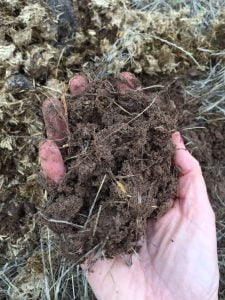
21/9/10
IRRITABLE BOWEL SYNDROME
2/4/11
Hi so an update in my horse diagnosed with inflammatory bowel disease, bought your sand colic recipe and hoped for the best after $1000 bucks worth of vet bills and i get staff discount and one of the best equine medicine specialist later no improvement. The horse looked like death and i was about to get my husband to get of out the gun. Gave him your recipe and waited wow there was some sand holy crap indeed, spoke to a vet that is a little more conventional that i also work with and she admits to using your drench on here own horses and that i could not tell any of the other vets she did (afraid of their response is suppose) so your theory that the sand could be causing the inflammatory response was right!!! The conventional vet said also the honey would act as a natural anti inflammatory as well. The horse has stacked the weight back on and as shiny as ever.
Thanx Amanda best $25 spent ever
++++++
Hey John
How’s things? Good luck with that Shetty? He looks like trouble J
I have finally got around to giving your sand colic recipe to my friends TB. Given that I like to see the proof in the pudding so to speak. I collected a fresh sample the day after and proceeded to ‘sieve’ it to the best of my ability. Who knew that would be so hard! Much later and wishing that I had worn gloves I came up with what I have in the picture. A) how does it look and B) did I sieve it right?
20th May, 2010
+++++
Hello,
my name is Necia from WA, I emailed you last week after purchasing your colic recipe and said I would get back to you after I had given it to the horses. The one of concern to me was our welsh mare Apple, who has had 8 drenches in the 18months we have had her. (always at about 11-2am on a Sunday night!)I gave her the feed and kept her locked in for 24hrs, she is the only one who would not eat her whole ration, the others loved theirs. I had to discard the rest of hers finally because it went rancid in the heat. When I cleaned her yard out this morn I nearly fainted, I emptied my sons lunch out of his lunchbox and gathered as many handful of warm poo as I could fit into it and raced down to the vets. They are good friends of mine and were extremely sceptical, to say the least, when I told them of my intentions to dose the horses.
I burst in and yelled out, “Come and look at my poo!” and their eyes nearly popped out of their faces. (As did all the clients in the waiting room) It was priceless, what great fun it is to suprise people so much! They were floored at how much sand was in that poo, especially considering she was drenched only 10 days ago. We had a good look through it all for at least 10mins and they conceded that it may have done something after all. We plan on tube drenching her next week with a dose, considering she would not eat her whole dose in the feed even after having food withheld for 48hrs before and 24hrs during. Is that what you would recommend, I am convinced she probably still has a lot more in her and would like to get it out once and for all.
Did not notice any sand in the others poo, but still plan on giving them their follow up dose as we live on extremely sand country that doesn’t hold together well, and they are really chasing the green pick at the moment.
Great result, so satisfying to see something like that and fantastic not to have to put up with the shiny, shitty bums and tails for the next few days like with an oil drench. See you in Perth, looking forward to it, Necia.
++++++++
4th January, 2009
Dear Mr. O’Leary
I tried your recipe and I was probably like most people very skeptical my horse was colicing and I live in a Arizona where we have had problems with sand since I have had my horses. I keep them on metamucil to help. My horse had started colicing on Sunday we kept him moving it was getting worse when I got your recipe I gave it to him on Tuesday evening he wasnt wanting to eat but he did eat it with his pellets by the next morning. Can I say all day Wednesday I walked him and could tell he was in a lot of pain. By that evening he seemed to be doing better he had a movement just a little but I was still glad. But on Thursday morning in the light I could’nt believe the piles of sand that had come out of him. I’m a true beliver and thank you he is doing fine and I will give him another dose in 2 weeks. Thank you so much.
Tracy in Arizona
From: Tony Brown
Sent: Friday, March 30, 2007 1:54 PM
To: john oleary
Subject: sand colic+++++++++
On Monday 19/3 vet (Harbisons Vet Clinic, Gawler South Australia) was called to treat our 2 1/2 yr old filly, drenched with paraffin of coarse.***tues 20/3 filly was hospitalized and drenched with 5 lots of elect+yoghurt ,***3 lots of electrolytes***5 lots of parrafin oil**1 magnesium sulphate drench.
On friday 23/3 at 12.15 I called and they had introduced feed and gut sounds had supposedly slowed right down again so we were devastated .We decided to bring her home as I had found your website. It was strange that we were told that she was fine to come home just 3 hours later . We did ask how much sand had been evacuated from our filly but they couldn’t see any. After your treatment we had 2 days of scouring so it was difficult to see sand but these attached pictures are proof that after 5 days your sand colic
remedy has indeed saved our horse by evacuating the sand. Pictures are gravelly sand washed from just 1 piece of manure in a jar with water. There was 1/2 inch of sand left in jar.
Regards Tony and Renata
+++++++++++
Hi John,
I would like to thankyou for your recipe on removing sand from my horse. On late sat arvo I noticed my horse did not look right, I knew straight away that it was early signs of colic.Waste no time,ring vets,
he was treated with a pain killer and muscle relaxant.The next day he was no better and badly wanted to pass wind and manure but to avail.Call vet out again,this time he drenched with paraffin oil and sedated .On monday call vet out again and the same process was done with no change in the horse except he was passing the oil with little manure.Now 2 vets looked at this horse and both told me that the horse did NOT have SAND.By tuesday horse a little better,I was given 2 shots of ace to give to him morning and night,which I did.Horse down on the ground again tuesday night.Vets then tell me maybe its not colic and want to start blood tests.My bill was now about $800 and that was enough.
Out of desperation I looked into your web site and read about sand colic,it all made sense.I followed your advise and whacko my horse pooped sand and sand ,,he was a new horse within hours and he kept passing sand for a few days.As far as Im concerned your mixture saved my horse I cant thankyou enough.If only I had read your web site before I could have saved a whole heap of money.Thanks John
Cheers Deb
++++++
What a shame for horses, except your lucky one. Glad to have saved her. We got a bucket of stones up to 12mm out of a horse that had come home from the Vets a few years ago. The horse is now at Kadina. His name is ‘Bigfoot’ Some of you may know him.The same Vet practice had treated a yearling Riding Pony that was dying. 7 days later, they brought him around to my place. He was lying against the wall of the stable on an angle like a drunk. We treated him and by pure chance, the next morning I was in his yard when he began squirting a laundry bucket of pure sand. 100% pure sand. He now lives at Yankalilla. He was 10 hands high at the time and as I said, 12 months old but in a sandy paddock at the top of Seaview Road. Paraffin Oil is a failure and psyllium has not been proven. Well done.
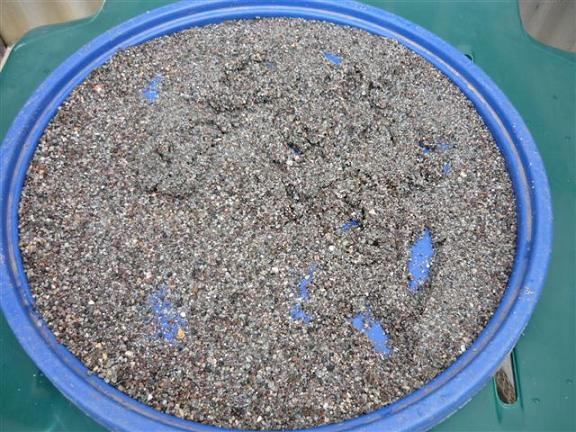
+++++++++++
Here is a recent study:
The ratio of sand moved by various feeds. Hay being the most effective.
OUR EXPERIENCES
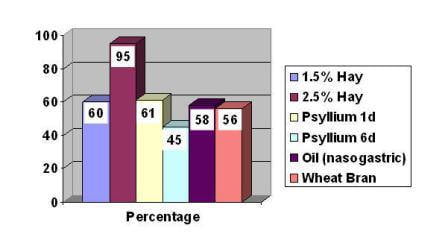
Having owned and run agistment centers’ throughout our career, I have keenly observed hundreds of horses that have come down with Colic. I have tracked their prior feeding regimes, stabled management by owners, exercise schedules, etc.
Given the fact that our horses do not get Colic, (TOUCH WOOD) here are the results of my life time observations of the prevention of Sand Colic. First to similarities:
-
- Horses are often over rugged.
-
- They are rarely exercised and when they are, never hard enough.
-
- They are not fed enough hay.
-
- Fitness level is rarely at a high enough level, giving rise to dehydration and stress when over worked.
-
- They are not wormed regularly or with rotated worming compounds.
-
- Their teeth are often not done.
-
- They are often over ridden when unfit.
-
- Rugged when too hot.
-
- Over drinking.
-
- An overall lack of observation by owners. (mainly caused by a lack of education)
Why then do our horses not get Sand Colic or any type of colic, come to think of it?
-
- They are always properly worked.
-
- They are always fit and if they are not they are never over worked.
-
- They are never over rugged.
-
- They are fed large amounts of cereal hay. (6 biscuits per day)
-
- They are only fed hard feeds on the days that they are worked.
-
- The manure is always a gauge of their inner health.
-
- Clean and plentiful water and an observation of water intake.
Other reasons why:
-
- They are wormed regularly
-
- Their teeth are always done on time.
-
- If stabled, they are always given time out to graze or run.
-
- If not in work, they are never hard fed.
-
- If recently spelled, they are brought along slowly.
-
- Close observation of the quality of feed is assured.
-
- If introducing new types of feeds, we do it progressively over a week.
-
- Stringent observation of feed is carried out and our noses inserted into all bales of hay.
Here is the cause of $1,000 Vet account of last week.
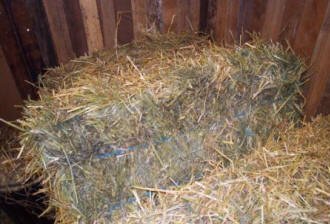
Rain on one side only during transit from the Fodder Store.The Rest of the bale was perfect hay. Consequently, only one edge of a biscuit in a Hay net was affected. Enough to put the horse in Hospital for 8 days.
Close up of the Fresh Mould.
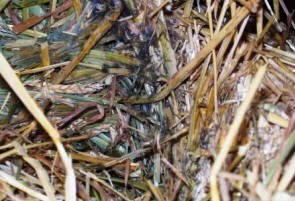
SELECTION OF HAY
Horse owners must be absolutely vigilant when purchasing hay for their horses. Lots of Hay sold in Fodder Stores is riddled with weeds of many descriptions. Lots of Hay is of a substandard quality. Some is moldy, mice infected and some has chemicals which can also kill your horse. Some horses are allergic to some of the chemicals that the Lucerne Industry uses and can suffer from horrific symptoms ranging from swelling of the lips, the throat or lumps all over the body. Some Lucerne Growers use a die to make older or weather beaten hays look new. They also use anti-mould agents. These too can affect horses.
Horses that do not like their hay go scavenging for every small bit of what they do like. They go searching in the dirt and sand. Think about it.
You can’t trust all of the Farmers or the Fodder Stores. You have to make your own judgments. You have to educate yourself. You have to know what is good feed and what is bad. Most City Folk do not. Here is what hay from our local Fodder Store did in one season.
Buy a large rubber mat and put it beneath your hay net. 2 metres by one metre. Paramount Browns.

The Farmer, one of the States biggest Professional Hay Suppliers, sent this from Quorn in the Far North and infested every front boundary of every Farm between there and Adelaide. Incidentally, the purple flower is the plant known as Salvation Jane or Patterson’s Curse. IT KILLS HORSES.
Provide a road base feeding site in your paddocks. (or even cement)
DEATH INVOLVING COLIC
It is perhaps relevant to give out observations of the reasons for horses dying from Colic.
-
- A failure of the owner of the horse to do the ‘hard yards’. To stay all night and to resist the temptation to go home for a nice little ‘cuppa’. ( twisted bowel ) This is another reason why we have never lost one. The horse gets tied up on cement and cannot lay down.
-
- A lack of supervision at Vet clinics when horses have to stay over. Horses rolling and twisting their bowel. If rolling is the most dangerous thing facing a horse with Colic, why would you leave your horse at a Vet Clinic then. So many of them do not supervise the horses over night and this can mean certain death. We have personally been involved in the deaths of horses left at Vet Clinics, where they have rolled during the night and died as a result. Why would you leave your horse at a Vet Clinic if the horse is going to be allowed to roll?????
CONFUSION AMONGST VETS
Why is there so much confusion amongst the Veterinary Community, regarding the treatment of Colic? Why is it that the Vets are really operating on a ‘wing and a prayer’ when it comes to this treatment?
-
- Some cringe at the suggestion of using ‘Berg Oil’ Others recommend it every time.
-
- Some drench with water as well as with the common treatment of Paraffin Oil, others do not.
-
- Some administer Electrolytes, others don’t.
-
- A small percentage will drench with Metamucil where most will only use Paraffin Oil.
-
- A lot say to walk the horse endlessly. Others say to lunge at the trot for 5 minutes, some say 10 minutes and one this week, 15 minutes.
-
- There is a view amongst some that it is ok for a horse with Colic to Roll, most say that it is not ok and definitely dangerous.
-
- The only possible time that a horse could be placed on a drip is if it eventually gets to the Vet Hospital. In most cases, THIS IS TOO LATE. Why does it not occur at the home of the horse?
-
- Some use and recommend Finniden (sp) as the drug of choice, others use Buscapan. (sp) Some say that Buscapan stops the stomach from working when it clearly needs to. Others dis-agree.
If 24/7 supervision exists at your Vet Clinic, there is no better place for the horse to be.
EARLY INTERVENTION
This is the key to success. There is no doubt about that. If you can recognize the symptoms, BEFORE rolling, and you take the correct steps, you should save the life of your horse.
This is the secret to the 100% success rate of cases where we have personally had charge or responsibility.
EFFORT
One of the biggest causes of Colic is the failure of owners to go the hard yards for their horses. A rather large percentage of horse owners, own a horse so that they may visit a stable complex and enjoy the fellowship of other horse owners’ and the gossip that goes with it. Just like Saddle Club but only for oldies. Nothing wrong with gossip, just do it around the Round Pen if you are a groomer, not a rider..
EDUCATION
Apart from these points and others, there are very few options for treatment in the knowledge base of Vets. There should be more. They are stuck with the Paraffin Oil theory and not much else. Not their fault. This is obviously all that comes out of the Colleges.
Why does Pony Club not teach every kid in the land about this subject? Why don’t the other Institutions? Why does not the Vet Peak Bodies see to it that the multitudes are education? Why is there no written information given out?
AN ALTERNATIVE VIEW
31/12/05
I notice a new wave of Colic has hit this State. I have thought long and hard over the years, very observant, analytical, thinking outside the square and reading horses. I have cut a lot open and conducted further investigation in the search for knowledge.
We lost a 3 year old last week. Twisted bowel before it arrived at our place for treatment. No sand, no worm damage. A giant impaction larger than a Basketball. Nothing in the lower bowels. No matter how good your treatment is at that stage, nothing will work. It is too late. But what triggers bouts of Colic attacks in Districts or areas? Ever wondered?
I have come to the conclusion that it is mostly weather related. Sure there are other factors that compound the conclusion but the trigger is weather related. I have never read such an opinion amongst the countless searches of Veterinary Studies World wide so forgive me any Vet who reads this.
There is no doubt that the 3 year old died of Colic simply because of a change in the weather which triggered playful rearing, fighting and rolling. During the aggressive rolling, which I note is different than normal rolling when letting a horse out of the stable into a paddock, they accidentally twist the bowel. The other interesting observation that I have made is that a certain conformation of horse can be susceptible to such a fate. The pod gutted type that looks half pregnant all the time.
Last night, another lovely performance horse belonging to a client, died of Colic after running around and sweating. She had a twisted bowel. Just 5 minutes ago, a lady rang with another one. I suspect sand but the trigger being 42 degrees and sweat causing rolling. If this is true, and I believe it is, it goes directly against some Vet opinion that it matters not if horses roll whilst having Colic and proves the danger of Vets leaving your Hospitalized horse unsupervised in a yard over night. Yet another angle on the greatest cause of death in horses.
SWEETBULK
I have asked but they cannot supply any studies or proof that it works.
MORE CASES
A yearling riding pony colt came to us a few years ago. It had been on deaths door with sand colic 7 days prior and was drenched by a very respected horse Vet. With Parrafin Oil. When it arrived, it was having extreme difficulty in standing up and was using the walls of the stable as a prop. The level of pain must have been massive.
We treated the poor little boy with an alternative treatment that had been passed down through the family over a couple of generations, from Uncle Joseph O’Leary, one of the most regarded Horse Vets in Australia, back in the 1940’s. Go here for that cure. In Naracoorte, in the South East of South Australia, the Horse Cemetery was owned by my Family. They used to cut all the horses open and check their guts. 4 gallons of sand was often seen and was obviously the cause of death of many horses. The District is sandy.
For many years, I have been promoting this to various Vets but to no avail. (Didn’t come from Vet school so how could it be any good) Every month I prove them wrong and Jo O’Leary right.
Contact me for details regarding the treatment.
4th August, 2005.
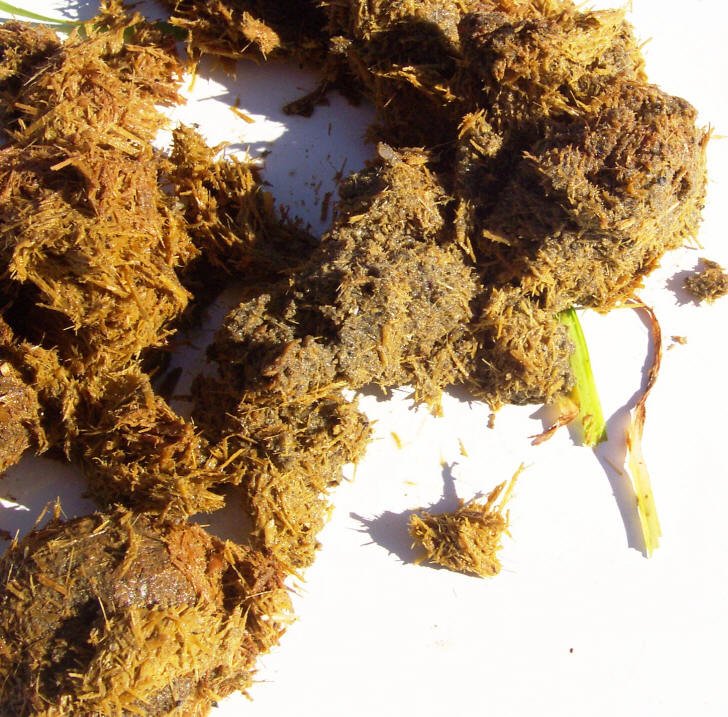
Here is a photo of manure taken from one of our horses that was treated 10 days ago. This has been evacuating from this horse every day and still going.
Now I want you to bear in mind that this little ‘fulla’ was only 10 hands high and a yearling. The following morning, in front of our eyes, he passed a 4 litre bucket of pure sand. Thus proving that Paraffin oil treatment does not work. This also showed just how much sand a horse can ingest and not eliminate, in 12 months.
On another occasion, and there have been many, we had an 18 hands high Shire. He had been seriously ill for 48 hours and had been treated by two Vets’, with no effect. In the end, we drenched him with our recipe and the following morning he passed approx 5 litres of gravel with stones up to 12mm in diameter. Thus proving that Paraffin oil does not work as the main remover of sand but it can obviously aid in compaction type colic and is a good indicator of things passing through the system. Veterinary opinion given to me recently agrees with this and the Vet added that drenching with water does a better job. My point here though, is that don’t necessarily think that because your horse has been drenched with oil that it is going to be rid of sand. Don’t rely on that fact, for your horses sake. Pour Paraffin oil in a bucket with sand. Swish it around. Watch the sand settle immediately to the bottom of the bucket and the Paraffin sit above. Now imagine the oil in the gut at 40 degrees C. Would it thin more? Would the sand in the bottom of the gut be settled hard and contain other gunk within it? Would it be swirling around so that the oil could catch it? I think not.
‘NEVER LET A HORSE GET DOWN IF YOU SUSPECT COLIC’
-
- We have handled hundreds of cases and never lost one. The main reason is that they were never allowed to get down and roll. Rolling can and does cause a twisted bowel and it is normally this that causes death.
-
- For the reason above, we would never allow a horse to stay over at a Veterinary Surgery unless we could stay with it. We have seen a number of cased where horses have died due to rolling because of a lack of supervision. One on new years eve. You cannot blame the Vet but you can blame the owner.
-
- We have had horses tied up for 50 hours and saved their lives.
-
- We have never walked horses. I see horses walked endlessly and wonder how I would like that if I had a massive stomach ache. If exercise is required, we will lunge at the trot briefly.
-
- Lunging a horse for a short period can assist. At the trot. (max 10 minutes)
CAUSES AND TREATMENT OF RUNNY MANURE
-
- Worm infestation
-
- Worm intestinal damage
-
- Sand build up in the gut
-
- Sand damage to gut
-
- Ulcers
-
- Old Age
-
- Bacterial infection or imbalance in the gut
ANOTHER O’LEARY FAMILY HELP
One O’Leary Yarn and another remedy for you from my Uncle Joe the Vet. Dennis O’Leary had a horse that was on deaths door. The exercise had been going for two days and Dennis knew the time was near where he would have to shoot the horse. The horse incidentally was 30 years old. As a final straw, he drenched him with another O’Leary Family remedy, a packet of Creme a tarta in the hottest possible water that could be used. Then he put the horse in the float and gave him a rough ride to the Pub, got two stubbies and then to the Abattoirs. Pulled up right next to a yard with a big old Bullock in it and who was near the fence. The horse was on the left side of the float and when Dennis opened the door, the horse put his head straight out as they do, looking straight into the eyes of this bullock who immediately roared like a Bull. The horse was besides himself of course. Anyhow, he drank the two stubbies while the horse had Kittens and then drove home. As he came out of the float, he opened up his legs as he was walking and dropped 4 big rock hard plugs of manure and immediately almost went to sleep at the tie up rail. He left him tied up there all night so he couldn’t roll and the next morning there was a wheel barrow of wet sloppy manure covering a metre square of ground and up the adjacent walls and post. Guess what, he was on the ride today, fit as a Bull and looking magnificent. Meanwhile, if you are ever constipated, take a teaspoon of it in hot water and make sure you aren’t too far from the toilet hahahaha.

SOME OTHER UNPROVEN TREATMENTS
When a horse has Colic, it is too late to be experimenting with new treatments. Here are a couple of others that associates declare does work.
“I was wondering if you know about the use of weetbix to help shift the sand from a horses stomach. We have used it on many horses that we have rescued from sandy ground. We normally feed approx 6 weetbix wet them down so that they are a gluggy paste and feed to the horse. This seems to sit in the horses stomach and when they poo it out it brings some of the sand with it. If large quantities of sand is suspected then we repeat 2 days later. We also place 2 to 3 weetbix in their morning and afternoon feed each day just dry and broken up. “
Equine Care Group Australia
HP -we got a horse from a Sandy area where he’s been for three years – NOTHING would fatten him NOTHING.
Wormed -fed all sorts of goodies, vet treated with injections.
fed psillium ten days each month tablespoon in each feed and in three months he is fat, round and can live off grass.
That’s good enough for me.
It might not be “scientific” but it worked..
MORE LETTERS
23/7/04
Hello there
Just wanted to give you a big thanks for the ——————— cure for colic.
Whilst Thor was no longer laying down from colic he was still sweating a lot and would be reluctant to do more than a trot.
Two days after trying this he is cantering and moving much better, more alert and not sweating the way he was!
Whilst I havent been able to see what came out of him (hard to know on 30 acres with three other horses using this same ground) I do believe that this treatment has cured whatever was still ailing him.
He had his feet done the same morning I was to administer and even the farrier commented on how much he was sweating just doing his hooves! This has ceased since I gave the treatment to him.
Thank you so very much for your help, oh and a very big thank you for including me in your weekly tips!
21/3/04
Thankyou so much for giving me the home remedy for sand colic. We administered it on Monday night and over the following three days our yearling Arabian colt passed over a kilogram of stones and grit. He is now on the mend and much brighter.
We are currently in a drought and had been feeding him his hard feed in a feeder but like most horses he dropped a bit on the ground around and we think he was picking the dirt and stones up with the dropped feed. Just in case he has been eating it intentionally we have introduced Bentonite supplements into his feed as well as a salt/mineral block into his yard.
Anyway he is no longer looking depressed, no more colic and is eating and drinking very well.
Thank you again for all your help as we believe it very well may have saved his life.
Hi john,
we had success! My daughter’s horse Govner is ok now,but it was 5 long days & nights. We gave him the remedy friday night, a few hours later he passed poo { much to our delight}! But he was still trying to lie down which we let him do occasionally but never allowed him to roll, it took another 24 hours after that for him to pass more sloppyer poo’s & for him to start feeling better, his appertite come back with avengence.We cannot be sure as to what did the trick but we want to thankyou for the recipe, we have also given it to our other horse. Should we do this twice a year & at what times is best?
The horses are on 30 acrs of sandy soil with grasses-no pasture has ever been planted, so its only started to green up & is very short right now. We rarely substitute their feed, only the occasional charf, horse nuts & phyllium at this time of year.
Could you please let me know what might be the best to feed them so that hopefully this Colic situation never happens again.
STUDIES
Here are the results of one of the few studies that I have been able to find. This is the only real attempt at testing the effectiveness of Psyllium. The product failed and yet Vets everywhere recommend it as a treatment.
TI: Failure of psyllium mucilloid to hasten evacuation of sand from the equine large intestine.
AU: Hammock-PD; Freeman-DE; Baker-GJ
SO: Veterinary-Surgery. 1998, 27: 6, 547-554; 28 ref..
LA: English
AB: Twelve ponies were assigned to a treatment (n=6) or a control (n=6) group. All ponies had an exploratory caeliotomy and 10 g/kg body weight of sand was placed into the caecum.
Ponies were fed a grain mixture alone at 1 g/kg (controls), a grain mixture plus psyllium pellets, each at 1 g/kg body weight (3 ponies), or fed a grain mixture and given psyllium powder by nasogastric tube at 1 g/kg body weight in 2 divided daily doses in 3 litres of water (3 ponies). Ponies were killed 11 days after surgery.
Sand was collected from the contents of the caecum, ventral colon, dorsal colon, and small colon. Dry weight of the recovered sand was compared between the 2 treatment groups as a percentage of the dry weight of sand placed in the caecum.
No significant differences were detected in the mean percentage of sand recovered between the treatment groups, with 39.2% recovered in ponies treated with psyllium and 27.4% recovered in control ponies.
It is concluded that psyllium mucilloid has no effect on sand evacuation from the equine large intestine. When intake of sand is prevented, the equine large intestine can reduce and possibly eliminate its sand burden.
I find it incredible that they did not test some by feeding hay. Hello? Horses weren’t born with grain feeds!!! Scientific minds I guess hehehe.
Should anyone come across documented evidence of any such product that works, could you please let me have it?
SOME EMAILS AND COMMENTS
G’day John,
Amongst other things on your site was reading the article on sand colic.
(quite) a few years ago we were at the stage with one horse with colic that it looked as though we were going to lose her or have to put her out of her distress. Nothing the vets were doing ( incl. copious amounts of paraffin ) was working and it was a fair bet that she was sanded – the symptoms were consistent with this being the cause.
I got in touch with all of the “old blokes” – practical horsemen from wayback – and amongst a number of already tried or too bizarre remedies was the following.
1 pk ( 375g. ) Epsom salts dissolved in water with a little molasses ( for 15 to 16 h.h. ) orally. Water must be available.
Repeat same time next day. Stay well away from rear end of horse thereafter.
After sand evacuated, feed cilium ( Metamucil ) for a few days to soothe gut.
This may seem a bit severe, however better for the horse than dying if it works. Have seen compacted sand evacuated, and could see where the paraffin had “washed over” the surface of it without penetrating so probably never contacted the gut. I suspect the Epsom salts may work by stimulating gut movement and / or drawing fluid through the gut beneath the sand. Who knows. Heavy doses of vitamin c also seem to work similarly but not as well.
All this may only be due to a series of co-incidences, or it may be worth consideration. I am not willing to recommend it overtly due the current litigious climate intruding on everything we do or say, however …………..
Regards and thanks for the great site,
Peter F.
p.s. Have been dealing a bit with bush horses from the N.T. over the last few years and noticed the occasional one with symptoms of sand rolling – not frantically – then after awhile evacuating sandy droppings and becoming normal.
Had a registered Vet administer a packet of Epsom to one today. “I wonder if they thought they had a clue?”
I tried your sand remover on my miniature, I wasn’t quite expecting to see pebbles and stones though. No poo photos sorry.
Regards,
Chris 17/9/05
Friday, July 08, 2005 – 02:53 pm
when Hugo came down with sand colic, he was drenched with paraffin twice, and was not getting better. On the third day the vet drenched him with Physillium husks and water mixed, from then on he improved. Just an idea. Wasn’t Harbisons though.
15/10/05
Very interesting, the head surgeon from Murdoch uni gave a talk on colic. He was the first vet I have heard admit that oils don’t remove sand, but they use it as a gauge to see if the horse is passing manure or has a complete obstruction. I was hoping to catch him on his own and mention your web site about your recipe. I tell people about it – but won’t give it to them as I think you deserve your money for it. I have given it to my horses, and touch wood have only used it as a preventative not for actual. But was great to see how much passed out of our new guys, and the different colours of sand etc from the different areas they have come from!!
MANURE OF THE STABLES AND YARDED HORSES
Healthy Manure (our Stallion)
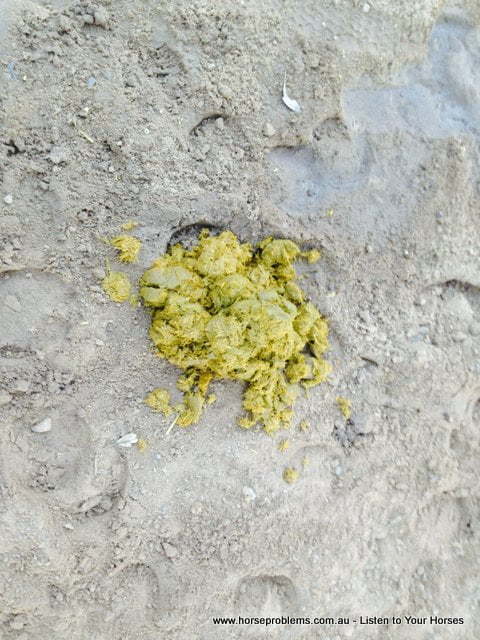
Unhealthy manure of a horse that had just gone to the Hospital for 8 days.
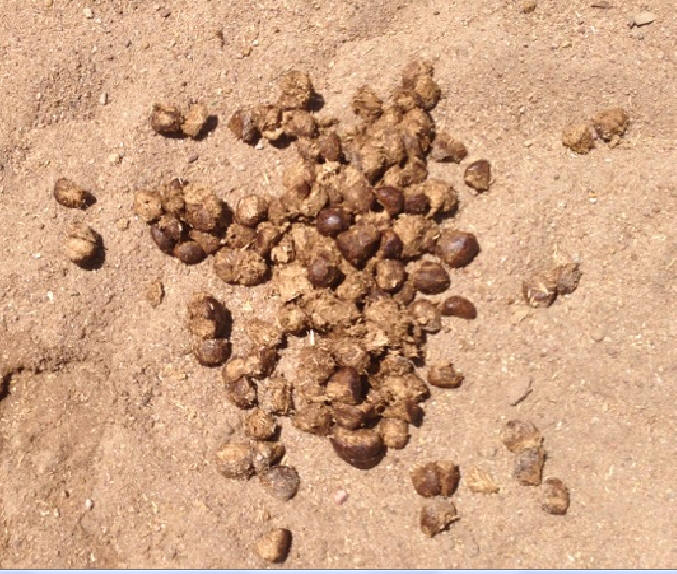
If your horse has manure like in the photo on the right, you could have Colic approaching!!
Excuse the photo’s. At last I have the excuse to get a new one. Yay.
So, I hope these experiences can help your horses in the future.
Oh, if in doubt, send your horse to Dr. Green for a couple of weeks. That is the best cure of all.!
STUDIES
A retrospective study of 40 horses that underwent surgical treatment for sand colic was performed. Three horses were euthanatized and one died during surgery. Of the 36 horses that recovered from anesthesia, five died before discharge from the hospital and seven died after discharge. Twenty-four horses survived at least 12 months. Sand impaction of the right dorsal colon was present in 26 horses. In addition to sand impaction, 10 horses also had colonic displacement or volvulus.
FROM A THIRD YEAR AUSTRALIAN VET STUDENT
That said, the main recommendation is actually to use psyllium as a preventative, although my lecturer admits there is no hard evidence that it is successful, and the volumes that need to be given to be helpful are in the extreme (0.5-1.0g/kg body weight). I had a hard enough time trying to convince my horse to try a cup full, let alone half a kg!
In my brief couple of weeks doing prac work at 2 equine practices, yes paraffin drenching is pushed as a preventative, and I have a feeling (note, this is my opinion ONLY) it may be because nothing else has been proven to be more effacious, and there is a ‘better to try than tempt fate’ mentality. Nothing wrong with that IMO.. at least while the vet is out, there is the oppurtunity to educate owners as to the risk that sand faces, and other preventative measures that can be taken, such as feeding large quantities of roughage, etc.
However, in my experience, this rarely actually happens, and unless the vet has been specifically asked to give the horse a basic checkup, or quizzed about prevention, it seems to be a case of come-drench-leave.
PARRAFIN OIL ONLY REMOVES MAX 26.1% OF SAND
13th February, 2008
Mineral oil, a traditional equine laxative, clears sand from the equine intestine more effectively when used in conjunction with psyllium, according to new research from the University of Veterinary Medicine Vienna, in Austria. These results are especially important for horse owners in geographical areas where the incidence of sand colic is high.
In this study, researchers quantified the amount of crude ash excreted by horses that were fed identical quantities of sand. In this crossover study, the researchers examined 12 horses’ sand output after administering mineral oil alone and mineral oil in conjunction with psyllium, a bulk-forming laxative made from the seeds of Plantago plants. Each group was examined under both treatment protocols, with a rest period between study phases.
The horses were given sand for five days. Following the “loading” period, they were treated according to their assigned group. Total feces were collected and weighed daily during the treatment period and were examined for crude ash output, which is indicative of the amount of sand passed.
While some horses naturally cleared sand more effectively than others, the researchers found the mineral oil/psyllium combination to be more effective overall than oil alone. Horses treated with psyllium and oil together excreted a mean of 51% of the sand administered, compared to 26.1% when administered oil alone. The study authors noted that the effectiveness of psyllium given alone should be examined in a future study using these protocols, as psyllium is easy to administer as a top dressing on feed and clearly indicated for use as a prophylactic treatment for horses living in sandy areas.
According to Christine Iben, VMU, DVPH, faculty member in the Department of Veterinary Public Health, a part of the Institute of Nutrition at the University of Veterinary Medicine Vienna, and lead author on this study, future research projects will be designed to further the scientists’ understanding of the role of mineral oil. The researchers will also work to calculate the lowest effective dose of psyllium.
“As soon as we will get some financial support for further trials, we will continue,” Iben said.
Well Folks, regardless of all the Science, they can’t beat our one. It has kicked ass for over 60 Years and proven thousands of times and 100%. The Old Horseman know a bit too

Listen to Your Horses

